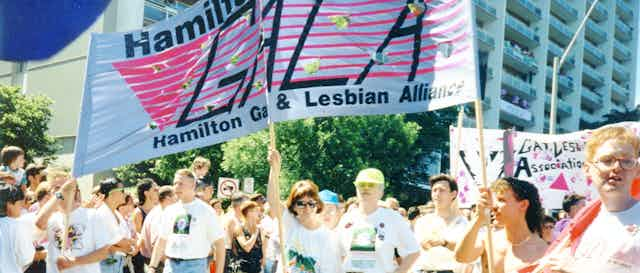With anti-2SLGBTQ+ protests and hate and violence against 2SLGBTQ+ communities on the rise, it’s a tough time to be queer or trans in Canada.
2SLGBTQ+ people and organizations have a long history of resisting efforts to harm or erase us, and much of that history is preserved in community-based archives.
The Canadian Gay Liberation Movement Archives was founded in 1973 and still exists today as The ArQuives: Canada’s LGBTQ2+ Archives. There are also a growing number of smaller 2SLGBTQ+ archives across the country.
Since 2020, I have been helping to build a 2SLGBTQ+ Community Archive in Hamilton, Ont. My students and I are often amazed at just how long 2SLGBTQ+ communities have been resisting very similar kinds of backlash, hate and violence to what we’re seeing today.
Anyone concerned about 2SLGBTQ+ struggles today can learn from the history of resistance and activism preserved in these archives.
Narratives about saving children
In the 1970s, gay and lesbian groups successfully fought back against conservative U.S.-based celebrity Anita Bryant’s “Save Our Children” campaign. Today, Bryant’s anti-gay sentiments are amplified by campaigns like the “1 Million March 4 Children.”
Read more: How the 'parental rights' movement gave rise to the 1 Million March 4 Children

But we can learn from the successful tactics of 2SLGBTQ+ organizers who fought against those campaigns. By building alliances with labour groups, progressive churches and more, these activists held successful counter demonstrations across Canada, from Toronto to Winnipeg to Edmonton to places as small as Moose Jaw, Sask.
More than a decade after these events, organizations like the Hamilton United Gay Societies (HUGS) and the Gay and Lesbian Association of McMaster refused to forget the hate-filled vitriol of Bryant’s campaign. They exposed her tactics in their monthly newsletter and reminded readers about the power of the counter-demonstrations that took place.
Lack of BIPOC and trans representation
My students and I noticed right away that the gay and lesbian people and histories documented in 2SLGBTQ+ archives were mostly white. There is very little representation of Black, Indigenous or other racialized groups, and also very little representation of trans lives and histories.
Many 2SLGBTQ+ archives are now working to remedy these gaps in their collections by actively seeking to collect materials from racialized queer and trans community members.
From these gaps we can learn about the ongoing effects of racism and transphobia within 2SLGBTQ+ communities. While building the Hamilton 2SLGBTQ+ Community Archives, we began with a series of critical conversations intended to get us thinking about how to move beyond centering whiteness in our collections. We learned about how essential it is to have the diversity of 2SLGBTQ+ communities represented from the outset.
Today, there are also stand-alone archives in Canada for two-spirit and trans communities, while projects like Marvellous Grounds in Toronto produce alternative archives of racialized queer and trans people.
The long history of struggle to address racism within 2SLGBTQ+ communities prompts us to be mindful of where and how racism shows up in our present-day organizing. For example, a lot of concern has recently been expressed about the number of Muslim participants in the “1 Million March.”
While we do need to keep talking about the role of religious groups and leaders in these movements, we can also learn from the struggles queer Muslim groups face to address Islamophobia, racism and homo/transphobia all at once. In the ArQuives, we can learn about groups like Min-Alaq, one of the first organizations for gay, lesbian and bisexual Muslims in Canada.
Today, queer Muslims are speaking out about anti-LGBTQ+ rhetoric from some Muslim organizations, and calling on all of us to prioritize the needs and well-being of queer Muslim youth. If we want to meaningfully redress those gaps in queer archives, we have to begin by learning from the organizing efforts of racialized queer and trans communities, historically and today.
Resisting policing

My students sometimes start out thinking their generation is the first to push back against police discrimination, harassment and violence.
However, these archives show us that 2SLGBTQ+ communities have been resisting unjust police practices for a long time. We can learn from the strategies and tactics of the organizing done in previous generations, if we know where to look for them.
For example, in the organizational records of HUGS we found one document from 1981 that lays out several concerns the community brought to the Hamilton-Wentworth Regional Police following increased police harassment of people presumed to be gay.

Community members wanted to know how decisions were made to target the gay community — and who was making these decisions.
They also wanted to know how to lay a complaint against a police officer for harassment or verbal abuse.
This approach demonstrates a clear opposition to police interaction with 2SLGBTQ+ communities.
It can be understood as an early precursor to later actions that have challenged police involvement with the community, including restricting their participation in Pride.
Keeping 2SLGBTQ+ archives alive
In a 1973 pamphlet calling for donations to the Canadian Gay Liberation Movement Archives, the collective noted that building an archive is “painstaking and timeconsuming work.” Now that I have a bit of first-hand experience with building an archive, I couldn’t agree more.
Most 2SLGBTQ+ archives survive on the labour of volunteers and on donations from members of our communities. Queer archives, according to archivist Rebecka Taves Sheffield, need at least three things to survive: space, money and expertise. To that list I would add that they need visitors, and not just students or academics like me, but anyone interested in learning from past social movement struggles.
In a time when anti-2SLGBTQ+ movements are becoming more vocal, and trying to push 2SLGBTQ+ communities out of public spaces, these archives are an essential resource for preserving histories and providing strategies for resistance.

